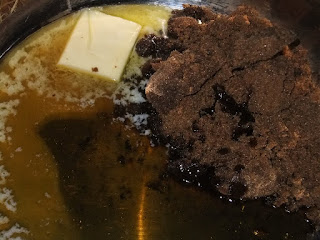First, honey, dark sugar and butter are melted in a pot (which will also be used to make the batter).
Next, flour and baking powder are mixed with powdered ginger, nutmeg and cinnamon.
The dry ingredients are stirred into the melted ingredients with ground almond until a thick, tough batter results.
The batter is chilled overnight until it's firm and malleable. It can then be rolled out and cut into shapes, but I used my trusty tart pan to shape them while they baked at 180C, turning them over and flattening them out with a spoon about two-thirds of the way into the baking.
Once baked and fully cooled, they can be glazed with a simple glaze of confectioner's sugar mixed with a little water. The lebkuchen can be served cold, and if baked dry enough, will keep for a long time.
For the stollen, chopped candied fruit and raisins are drizzled with vanilla and almond extracts, sprinkled with grated lemon peel, and mixed in with ricotta cheese, egg and egg yolk, and toasted almonds.
Flour, sugar, baking powder and a pinch of salt are mixed with butter until a crumbly texture results.
The dry ingredients are mixed in with the wet ones and the resulting dough is kneaded and molded into a loaf on a floured baking pan.
Baked at about 180C, it will rise a little, and brown a crust.
The stollen loaf can then have confectioner's sugar sifted over it for a traditional look.



















































